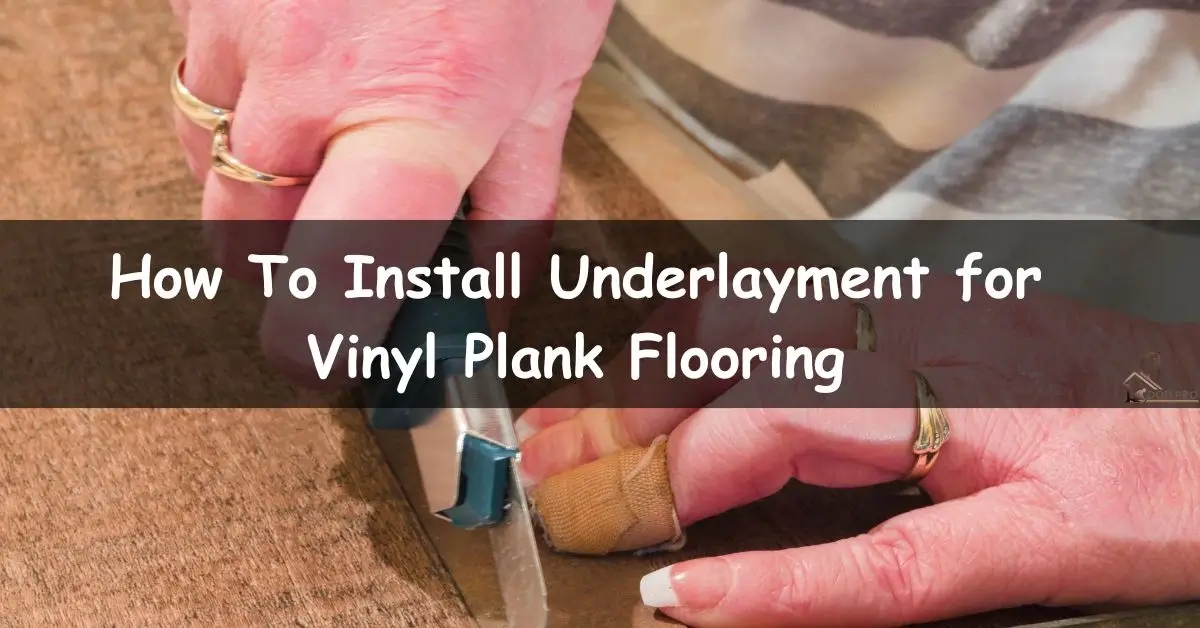Installing underlayment for vinyl plank flooring is an important step that helps your floor look and feel great. The underlayment creates a smooth surface for the planks, makes the floor more comfortable to walk on, reduces noise, and can even protect against moisture. Whether you’re new to DIY projects or have some experience, learning how to install underlayment correctly is simple and will help your flooring last longer in this guide. We’ll walk you through each step in an easy-to-follow way so you can finish the job smoothly and with confidence. Let’s dive in.
Looking to install vinyl tile flooring on concrete? Click here for a detailed guide
Tools Needed for Installing Underlayment for Vinyl Plank Flooring
Here are the tools which are needed for Installing Underlayment for Vinyl Plank Flooring
Utility Knife
For cutting the underlayment.
Tape Measure
To measure the room and underlayment accurately.
Straightedge or Ruler
To guide precise cuts.
Scissors
For trimming edges.
Stapler or Staple Gun
To secure the underlayment, if needed.
Seam Tape
To seal seams between underlayment sections.
Floor Roller
To smooth out the underlayment and ensure proper adhesion.
Vacuum Cleaner or Broom
Clean the subfloor before installation.
How to Install Underlayment for Vinyl Plank Flooring
Installing underlayment for vinyl plank flooring helps create a smooth, stable surface for your new floor. Here’s an easy step-by-step method on how to do it:
Prepare the Subfloor
Start by cleaning the subfloor. Sweep it well to eliminate any dust or dirt that could get in the way of the underlayment. If any nails or holes in the floor are sticking up, fix them to avoid problems.
If installing the flooring on concrete and you’re worried about moisture, add a vapor barrier first. This will protect the underlayment and vinyl from humidity.
Lay Out the Underlayment
Next, roll out the underlayment or place the underlayment tiles over the clean, prepared subfloor. If you used a vapor barrier, lay the underlayment on it.
Make sure there’s a small gap (about 1/4 inch) between the underlayment and the walls so it has space to expand.
Use Adhesive, Tacking, or Dry Lay Methods
Some underlayment must be glued, taped, or tacked to the floor to stay in place, especially in areas with heavy foot traffic. Other types can just be dry-laid, meaning you don’t need glue. Check the instructions for the best method for your underlayment.
Continue Until You Reach the Wall
Keep laying the underlayment across the room, cutting it as needed. If your vinyl planks are thick or you want a neater look, you may need to remove the baseboards so the underlayment and vinyl fit under them.
Cut the Underlayment
When you reach a wall, use a utility knife (or scissors for thinner underlayment) to cut the material to fit perfectly against the wall. Make sure the cut is straight to avoid gaps.
Secure the Underlayment
If you’re using rolls of underlayment, tape the seams to keep the pieces together. Be careful not to overlap the edges, creating bumps under the vinyl.
Types of Underlayment for Vinyl Plank Flooring

Selecting the right underlayment is essential when installing vinyl plank flooring, ensuring comfort, noise reduction, and durability.
Foam Underlayment
Foam Underlayment is commonly used because it provides soundproofing and protection. It’s perfect for vinyl planks without an attached underlayment, especially in apartments or multi-story homes where noise control is important.
Cork Underlayment
It offers additional benefits such as natural sound absorption and moisture resistance. This eco-friendly option is perfect for those seeking a sustainable solution that reduces comfort and noise in living areas like bedrooms and living rooms.
Felt Underlayment
It is another option that excels at soundproofing and providing extra cushioning. It’s especially good for reducing impact noise and is often used in homes where comfort and quiet are top priorities.
Rubber Underlayment
For areas that experience high traffic or moisture, Rubber Underlayment is a strong choice. Made from recycled rubber, it offers durability, soundproofing, and moisture resistance, making it ideal for high-traffic areas like hallways or basements.
Plastic or Vapor Barrier Underlayment
It is designed to prevent moisture from seeping into the vinyl planks, protecting the flooring from damage. It’s particularly beneficial in basements or other spaces with potential moisture issues, ensuring the longevity of your flooring.
Pre-attached Underlayment
Lastly, some vinyl plank flooring comes with Pre-attached Underlayment, which can save time and effort during installation. This option eliminates the need to purchase separate underlayments, making it convenient for those looking for a quick and easy installation process.
Benefits of installing underlayment for vinyl plank flooring
Installing underlayment for vinyl plank flooring offers several important benefits:
Improved Comfort:
Underlayment provides a cushion between the subfloor and the vinyl planks, making the floor feel softer and more comfortable underfoot, especially when standing for extended periods.
Noise Reduction:
Underlayment helps reduce sound transmission, minimizing noise when walking on the floor. This is particularly important for multi-level homes or apartments.
Moisture Protection:
Many underlayment materials come with moisture-resistant properties, protecting the vinyl from any potential moisture from the subfloor, which is especially helpful in areas like bathrooms and kitchens.
Enhanced Durability:
It helps to smooth out minor imperfections in the subfloor, reducing wear and tear on the vinyl planks. This can extend the lifespan of your flooring.
Improved Insulation:
Underlayment can provide additional thermal insulation, helping to keep the room warmer in the winter and cooler in the summer.
Easier Installation:
The underlayment can create a more stable base for the vinyl planks, making the installation process smoother and more efficient.
Subfloor Protection:
It acts as a barrier to protect the subfloor from potential damage due to moisture or movement of the vinyl planks over time.
Conclusion
Installing underlayment for vinyl plank flooring is an important step that helps make your floor more comfortable, quiet, and long-lasting. It creates a smooth surface, reduces noise, and protects against moisture. Whether you’re new to DIY projects or have some experience, installing underlayment correctly is easy. With the right material and a little care, your vinyl plank flooring will look great and stay in good condition for years.
FAQs:
Q1: Why is underlayment necessary for vinyl plank flooring?
A: Underlayment provides comfort, noise reduction, and moisture protection, ensuring the vinyl planks stay durable and smooth over time.
Q2: How do I choose the right underlayment for vinyl plank flooring?
A: Choose underlayment designed for vinyl floors based on your subfloor type, moisture needs, and soundproofing preferences for optimal performance.
Q3: Can I install underlayment, or should I hire a professional?
A: You can install underlayment yourself if you’re comfortable with DIY. Just ensure the subfloor is clean and follow the manufacturer’s instructions carefully.
Q4: How do I install underlayment for vinyl plank flooring?
A: Clean the subfloor, lay the underlayment flat, and trim it to fit. Tape seams and leave a small gap at the edges before installing the vinyl planks


